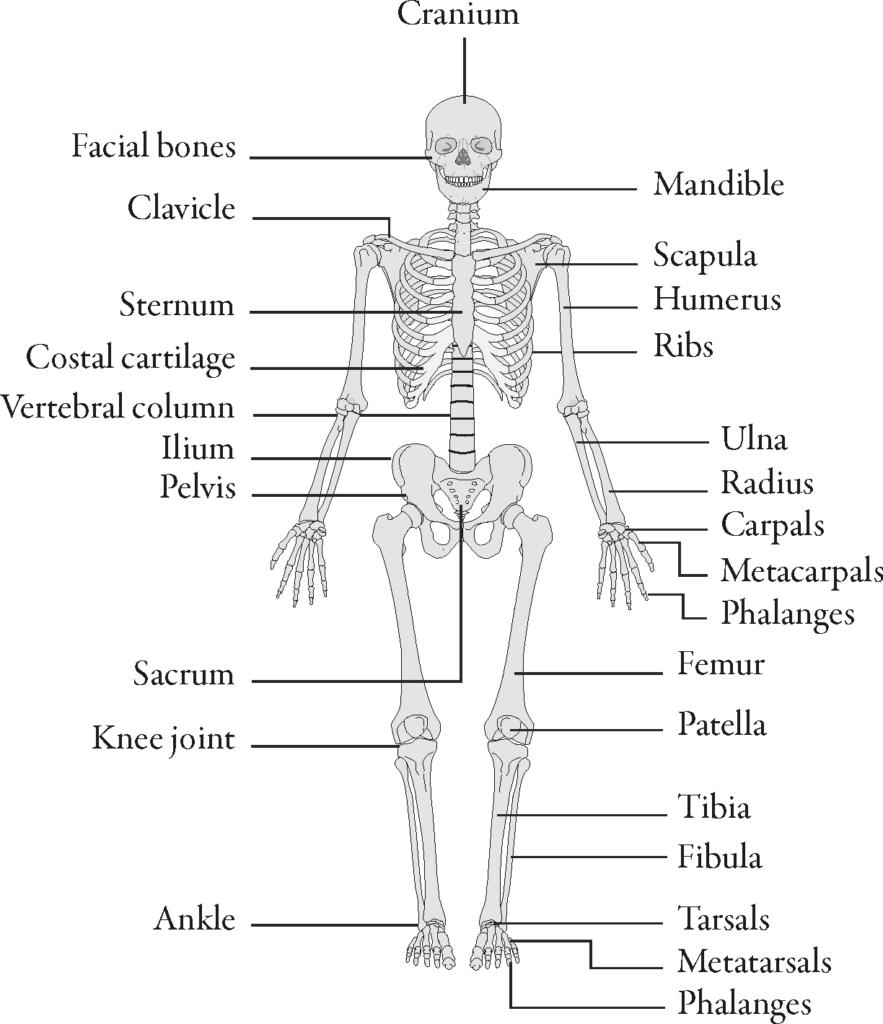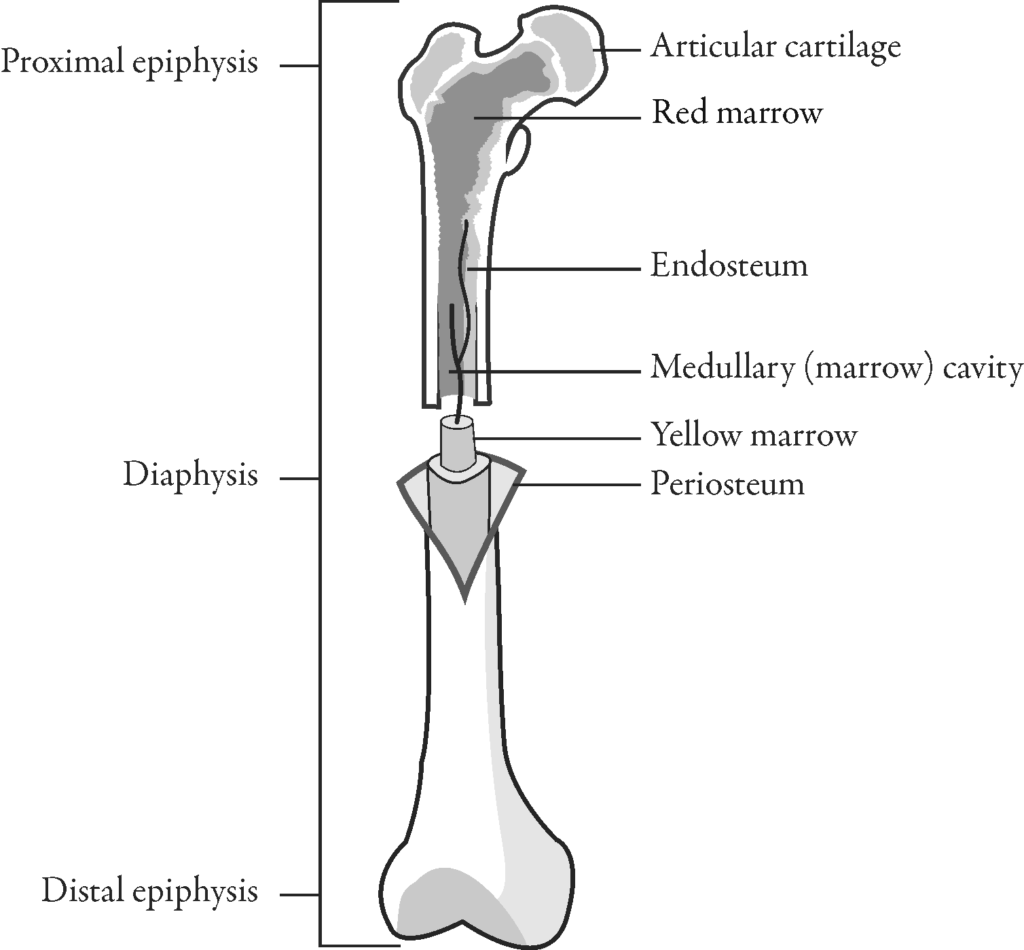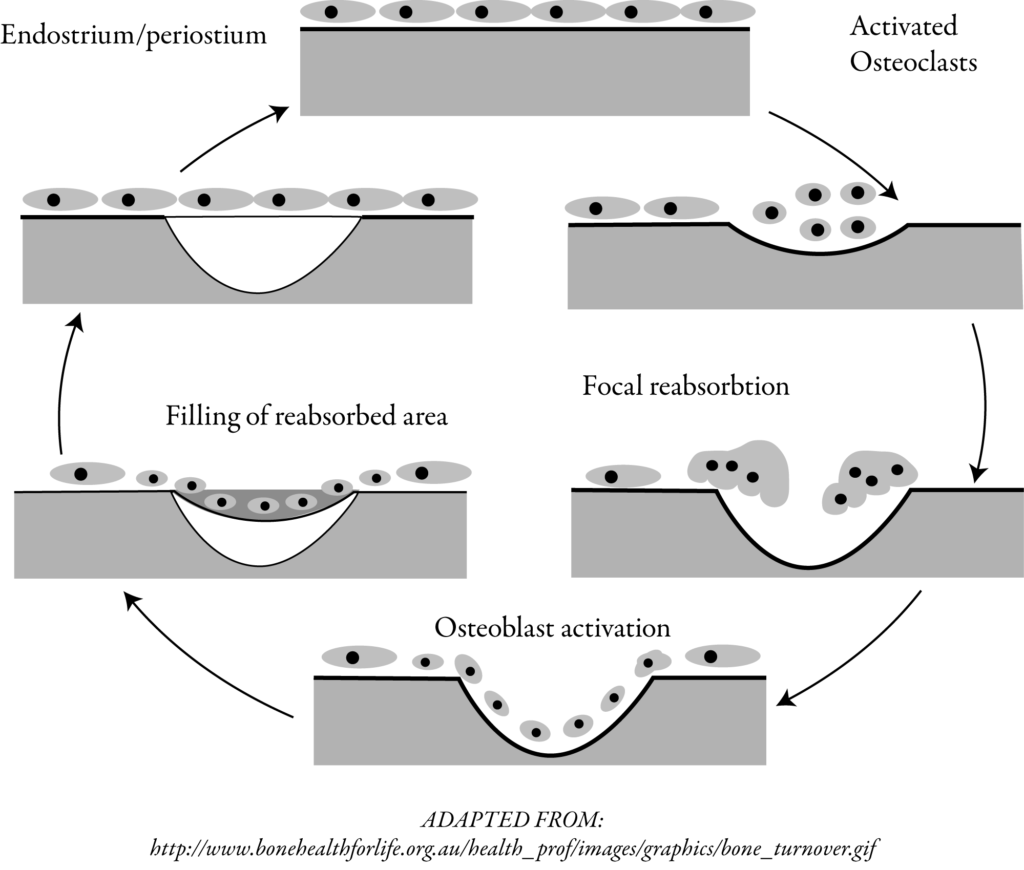Anatomy and Physiology of Bones
SECTION 1: Anatomy and Physiology of Bones
Learning Objectives
After reading this section, you should be able to:
- Name the three types of bone cells and state the function of each.
- State the location of cortical bone and trabecular bone.
- State the location of red and yellow bone marrow.
- Name the two types of membranes found in bones and state the function of each.
- List the main functions of bones.
- Describe the ossification, calcification and remodelling of bones.
Bone Structure
Bone is an active organ made up of bone cells and tissues.
1) Bone cells
Osseous tissue (bone tissue) is composed of three types of bone cells:
- osteoblasts* – Osteoblasts are bone-building cells that secrete collagen*
(a flexible protein) to form a matrix, which becomes calcified. - osteocytes* – Osteocytes are osteoblasts that have become surrounded by the calcified matrix. They maintain the bones, but do not produce new bone tissue.
- osteoclasts* – Osteoclasts aid in the resorption or breakdown of bone.
2) Bones
The skeleton is composed of 206 bones, some of which are shown in Figure 1.1‑1.
Figure 1.1-1: Skeleton

The bones of the arms and legs, shown in Figure 1.1-2, are referred to as the long bones. These bones have a long shaft, the diaphysis*, located between two ends, the proximal epiphysis* and the distal epiphysis.
Figure 1.1-2: Long Bone

Two kinds of bone are found in the body:
- cortical bone – forms the hard outer layer of bones. Cortical bone, or compact bone, is denser and has fewer spaces than trabecular bone.
- trabecular bone – found in the vertebrae, sternum, pelvis, and inner cavity of long bones. Trabecular bone, also known as cancellous or spongy bone, consists of interconnecting rods or plates of bone. It has low density and strength, but a very high surface area.
Bones contain two types of marrow:
- red marrow – found at the end of long bones and at the centre of other bones. Red marrow manufactures blood cells.
- yellow marrow – found mainly in the central cavities of long bones and contains large amounts of fat
3) Membranes
Two membranes are associated with bones:
- periosteum – covers the outside of bones. This membrane contains osteoblasts that are essential for the growth and repair of bones, blood and lymph vessels that help in the nourishment of bone tissue, and nerve fibres.
- endosteum – lines the medullary cavity (marrow cavity). It contains cells that aid in the growth and repair of bone tissue.
Functions of Bones
Bones have several functions:
- provide a framework for the body
- aid in the movement of the body
- protect delicate structures such as the brain, spinal cord, and the heart
- store calcium and phosphorus, which can then be released into the blood when needed
- produce blood cells in the red marrow
Bone Formation
Because bone is an active organ made up of bone cells and tissues, it is constantly being formed (ossification) and broken down (resorption). The process by which old bone is replaced with new bone is called remodelling. Bone remodelling (or turnover) is a continuous process that determines the size, shape, architecture, and strength of bone.
1) Ossification
Ossification begins during the second and third months of embryonic life. Osteoblasts secrete the organic intercellular substance of bone. Compared to mature bone, this immature bone has more cells and fibres and less mineral and cement substance. It contains a large amount of collagen. Ossification of all bones is complete by about the age of twenty-five.
2) Calcification
During calcification, calcium compounds are deposited within the intercellular material. When the osteoblasts are completely surrounded by the hardened intercellular material, they are referred to as osteocytes. Osteocytes maintain the bone and regulate bone metabolism.
The bones of children are relatively pliable because they contain more cartilage* and less calcium than bones of adults. Cartilage is composed of chondrocytes*, collagen, and a base substance made up of proteoglycans*.
As a person ages, cartilage is replaced by bone. Bones of older persons contain a higher proportion of minerals, as opposed to cartilage and collagen, and are therefore more brittle.
3) Remodelling
As shown in Figure 1.1-3, old bone is continuously replaced by new bone in a process known as remodelling. As the osteoclasts resorb bone, the osteoblasts renew the matrix.
Figure 1.1-3: Formation and Remodelling

Approximately 25% of the trabecular bone in the body is replaced every year. After adolescence, bone mass continues to increase, with peak bone mass being achieved at about age 30 to 35. Beyond age 30 to 35, the rate of bone resorption slightly exceeds formation, with a reduction in bone mass of 0.3-0.5% per year for men and women.
Some substances that are involved in the regulation of bone remodelling are listed in Table 1.1-1. However, the essential factors involved in osteoclast development and bone remodelling have recently been identified as the family of proteins RANKL* (receptor activator of NFκB ligand), its receptor RANK, and osteoprotegerin (OPG).
Production of RANKL by activated T-lymphocytes* directly controls osteoclastogenesis and bone remodelling. The binding of RANKL with its receptor results in formation of osteoclasts and the activation of mature osteoclasts. OPG acts as a decoy receptor and competes with RANK for RANKL binding. Thus OPG is an effective inhibitor of osteoclast maturation and osteoclast activation.
At menopause, women experience a period of accelerated bone loss lasting 10 years or more due to estrogen deficiency, after which they return to a stable rate of bone loss similar to men.
Table 1.1-1: Substances that Affect Bone Remodelling
| Promote bone formation and increase bone mass |
osteoprotegerin (OPG) androgen calcitonin estrogen growth hormone insulin-like growth factor I (IGF-I) vitamin D |
| Promote bone resorption and decrease bone mass |
RANKL
corticosteroids parathyroid hormone thyroid hormones (T4 and T3) |
SUMMARY — SECTION 1: Anatomy and Physiology of Bones
Bone is an active organ that contains cells and tissues. Bone tissue is composed of three types of bone cells:
- osteoblasts – secrete collagen to form a matrix that becomes calcified
- osteocytes – maintain the bones, but do not produce new bone tissue
- osteoclasts – aid in resorption or breakdown of bone
Long bones contain red marrow, which plays an important role in manufacturing blood cells and yellow marrow, which contains large amounts of fat. The periosteum covers the outside of bones and the endosteum lines the medullary cavity.
Bones have the following functions:
- provide a structural framework for the body
- aid in the movement of the body
- protect delicate structures such as the brain, spinal cord, and the heart
- store calcium and phosphorus which can then be released into the blood when needed
- produce blood cells in the red marrow
Bones undergo continuous remodelling by the osteoblasts and osteoclasts. Production of RANKL by activated T-lymphocytes directly controls osteoclastogenesis and bone remodelling.
PROGRESS CHECK — SECTION 1:
Anatomy and Physiology of Bones
1. List the 3 types of bone cells and state the function of each.
|
Bone Cells |
Function |
| … | |
| … | |
| … |
2. The type of bone located in the pelvis is called ______________________.
3. In long bones, red bone marrow is located ______________________
whereas yellow bone marrow is mainly found ______________________.
4. The periosteum surrounds the outside of bones and the endosteum lines the medullary cavity.
a) true
b) false
5. List 5 functions of bones.
1 _____________________________________________________
2 _____________________________________________________
3 _____________________________________________________
4 _____________________________________________________
5 _____________________________________________________
6. Another name for bone formation is ______________________.
7. The hardening of bone is due to deposition of ______________________ in the intercellular material. This process is called ______________________.
8. During remodelling of bone, ______________________ resorb bone
and ______________________ renew the matrix.
9. The essential factor required for osteoclast maturation and activation is ______________________.
PROGRESS CHECK ANSWERS — SECTION 1:
Anatomy and Physiology of Bones
1.
|
Bone Cells |
Function |
| osteoblasts | build bone |
| osteocytes | maintain bone |
| osteoclasts | breakdown/resorb bone |
2. The type of bone located in the pelvis is called trabecular bone.
3. In long bones, red bone marrow is located at the end of the bones
whereas yellow bone marrow is mainly found in the central cavities of the bones.
4. a) true
5.
1) provide a structural framework for the body
2) aid in the movement of the body
3) protect delicate structures such as the brain, spinal cord, and the heart
4) store calcium and phosphorus, which can then be released into the blood when needed
5) produce blood cells in the red marrow
6. Another name for bone formation is ossification.
7. The hardening of bone is due to deposition of calcium in the intercellular material. This process is called calcification.
8. During remodelling of bone, osteoclasts resorb bone
and osteoblasts renew the matrix.
9. The essential factor required for osteoclast maturation and activation is
RANKL (receptor activator of NFκB ligand).
